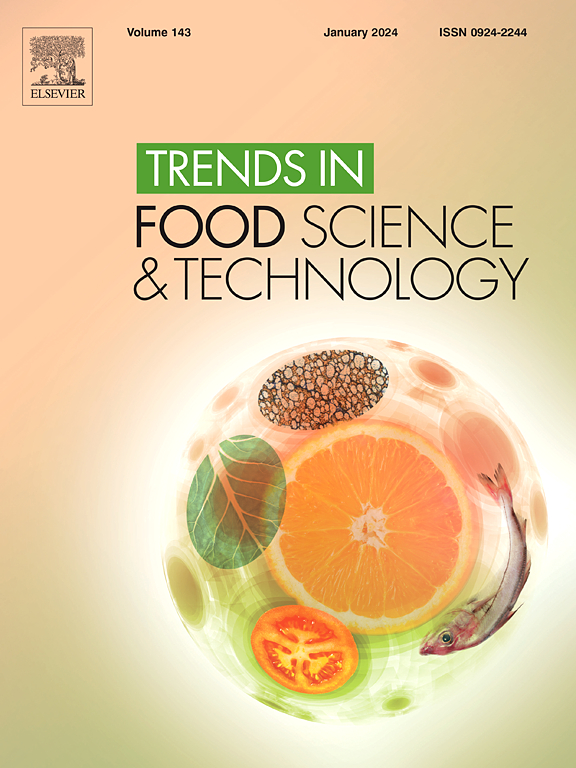冷等离子体和综合保鲜方法:机制、质量属性、挑战和未来方向
IF 15.1
1区 农林科学
Q1 FOOD SCIENCE & TECHNOLOGY
引用次数: 0
摘要
水果和蔬菜对我们的日常营养至关重要。然而,由于微生物腐败和相关的酶活性引起的快速分解,它们的保质期受到限制。冷等离子体(CP)等非热技术可以破坏新鲜农产品表面的微生物,但可能会影响其质地和生物活性成分。近年来,以cp为基础的保鲜保鲜综合方法已成为保鲜果蔬质量和提高食品安全的研究热点。范围和方法这篇综述强调了最新的CP和用于保鲜新鲜农产品的综合策略。全面论述了CP的产生机制、CP诱导的消毒机制、质量属性、面临的挑战、商业前景和未来发展方向。几种CP技术,包括介电屏障、电晕、微波供电和滑动电弧放电等离子体,在新鲜农产品中显示出前景。与单个处理相比,基于等离子体的综合处理在减少微生物负荷、抑制细菌生长和保持储存质量方面表现出更大的功效。抗菌剂、细雾、聚合物涂层、强脉冲光、真空冷却或改性大气包装与CP的结合以及有机酸、预冷、温和加热、超声波或微泡搅拌与等离子体活化水的结合已经显示出令人鼓舞的结果。需要进一步的研究来确认综合方法的潜力,因为还没有对各种农产品进行广泛的研究。应简化集成技术,以提高其实用性、可扩展性和商业可行性。必须对有害物质进行严格的研究,以确保cp处理食品的食品安全。本文章由计算机程序翻译,如有差异,请以英文原文为准。
Cold plasma and integrated approaches for fresh produce preservation: Mechanisms, quality attributes, challenges, and future directions
Background
Fruits and vegetables are crucial for our daily nutrition. Nevertheless, their shelf-life is restricted due to quick decomposition caused by microbial spoilage and related enzymatic activity. Nonthermal technologies like cold plasma (CP) can destroy surface microbes from fresh produce, but it may affect their texture and bioactive components. In recent years, CP-based integrated approaches have attracted the researcher's attention to preserve the quality of fresh produce and enhance food safety.
Scope and approach
This review highlights the state-of-the-art in CP and integrated strategies employed for the preservation of fresh produce. It has comprehensively discussed the CP generation mechanisms, CP-induced disinfection mechanisms, quality attributes, challenges, commercial prospects, and future directions.
Key findings and conclusions
Several CP technologies, including dielectric barrier, corona, microwave-powered, and gliding arc discharge plasma, have shown promise for fresh produce. The plasma-based integrated treatments have demonstrated greater efficacy in reducing microbial load, inhibiting bacterial development, and maintaining storage quality over individual treatments. The combination of antibacterial agent, fine mist fog, polymer coating, intense pulse light, vacuum chilling, or modified atmospheric packaging with CP and integration of organic acid, precooling, mild heating, ultrasonication, or micro-bubbling-agitation with plasma-activated water have shown encouraging outcomes. Further study is necessary to confirm the potential of integrated approaches, since they have not been extensively studied on a variety of agricultural goods. Integrated techniques should be simplified to improve their practicality, scalability, and commercial viability. Food safety for CP-treated foods must be assured by rigorous research on harmful substances.
求助全文
通过发布文献求助,成功后即可免费获取论文全文。
去求助
来源期刊

Trends in Food Science & Technology
工程技术-食品科技
CiteScore
32.50
自引率
2.60%
发文量
322
审稿时长
37 days
期刊介绍:
Trends in Food Science & Technology is a prestigious international journal that specializes in peer-reviewed articles covering the latest advancements in technology, food science, and human nutrition. It serves as a bridge between specialized primary journals and general trade magazines, providing readable and scientifically rigorous reviews and commentaries on current research developments and their potential applications in the food industry.
Unlike traditional journals, Trends in Food Science & Technology does not publish original research papers. Instead, it focuses on critical and comprehensive reviews to offer valuable insights for professionals in the field. By bringing together cutting-edge research and industry applications, this journal plays a vital role in disseminating knowledge and facilitating advancements in the food science and technology sector.
 求助内容:
求助内容: 应助结果提醒方式:
应助结果提醒方式:


